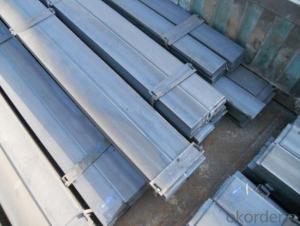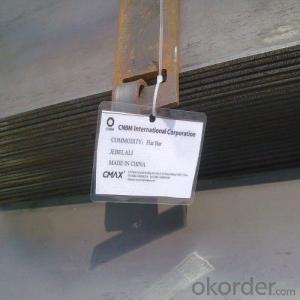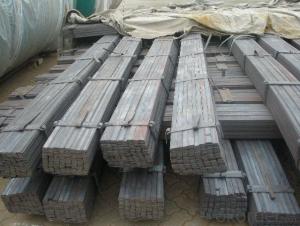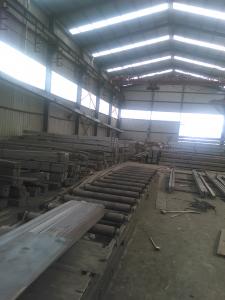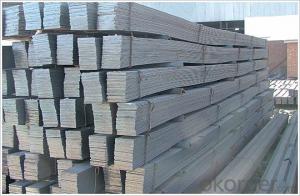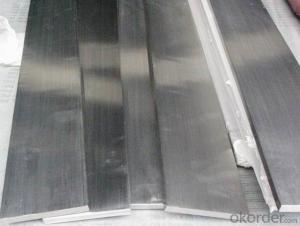Hot Rolled Flat Bars in Material Grade Q235
- Loading Port:
- Tianjin
- Payment Terms:
- TT OR LC
- Min Order Qty:
- 25 m.t.
- Supply Capability:
- 10000 m.t./month
OKorder Service Pledge
OKorder Financial Service
You Might Also Like
Product Description:
OKorder is offering high quality Flat Bar at great prices with worldwide shipping. Our supplier is a world-class manufacturer of steel, with our products utilized the world over. OKorder annually supplies products to European, North American and Asian markets. We provide quotations within 24 hours of receiving an inquiry and guarantee competitive prices.
Product Applications:
Flat Bars are ideal for structural applications and are widely used in the construction of buildings and bridges, and the manufacturing, petrochemical, and transportation industries.
Product Advantages:
OKorder's Flats Barare durable, strong, and resist corrosion.
Main Product Features:
· Premium quality
· Prompt delivery & seaworthy packing (30 days after receiving deposit)
· Corrosion resistance
· Can be recycled and reused
· Mill test certification
· Professional Service
· Competitive pricing
Product Specifications:
Manufacture: Hot Rolled
Grade: Q195 – 235
Certificates: ISO, SGS, BV, CIQ
Length: 6m – 12m, as per customer request
Packaging: Export packing, nude packing, bundled
Chemical composition of Q235
Alloy No | Grade | Element(%) | ||||
C
| Mn
| S
| P
| Si
| ||
Q235
|
B
|
0.12—0.20 |
0.3—0.7 |
≤0.045 |
≤0.045
|
≤0.3
|
Physical properties of Q235
Alloy No | Grade | Yielding strength point(Mpa) | Tensile strength (Mpa) | Elongation after fracture(%) | ||||||
Thickness (mm) | Thickness (mm) | |||||||||
≤16 | >16--40 | >40--60 | >60--100 | ≤16 | >16--40 | >40--60 | >60--100 | |||
≥ | ≥ | |||||||||
Q235 |
B |
235 |
225 |
215 |
205 |
375--500 |
26 |
25 |
24 |
23 |
FAQ:
Q1: How soon can we receive the product after purchase?
A1: Within three days of placing an order, we will begin production. The specific shipping date is dependent upon international and government factors, but is typically 7 to 10 workdays.
Q2: How do we guarantee the quality of our products?
A2: We have established an advanced quality management system which conducts strict quality tests at every step, from raw materials to the final product. At the same time, we provide extensive follow-up service assurances as required.
Q3: The products are invoicing on theoritical weight or on actual weight?
A3: We can do it in both manners, according to buyers' requiremnet.
Images:
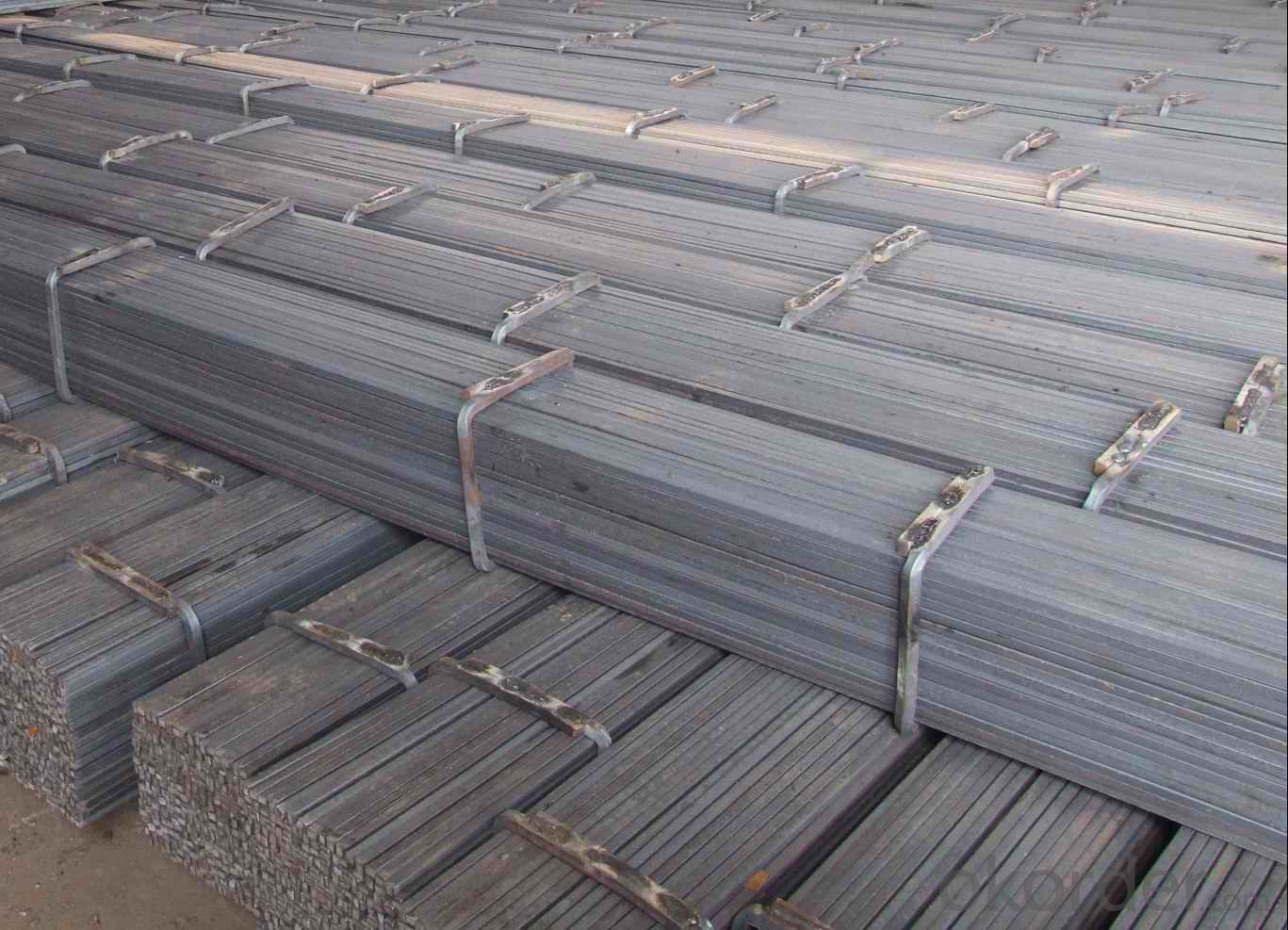
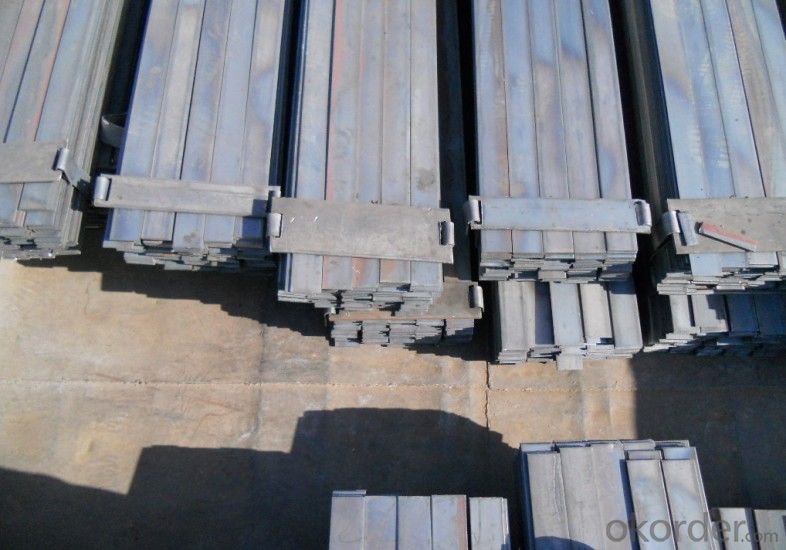
- Q:What are the different types of surface defects that can occur in steel flat bars?
- Some common surface defects that can occur in steel flat bars include scratches, pits, cracks, and rust. Scratches are shallow marks on the surface, while pits are small depressions or cavities. Cracks are more severe, as they can extend through the thickness of the bar. Rust refers to the formation of iron oxide on the surface, which can weaken the steel if not treated. These defects can affect the appearance, integrity, and performance of the steel flat bars.
- Q:How are steel flat bars stored or transported?
- Steel flat bars are typically stored and transported in a way that ensures their safety and prevents any damage. One common method of storage is to stack the bars horizontally on a flat surface such as a pallet or a rack. This allows for easy access and prevents any bending or warping of the bars. To further protect the steel flat bars during storage, they are often covered with a protective material such as plastic or cardboard to prevent any moisture or dust from affecting their quality. When it comes to transportation, steel flat bars are usually loaded onto trucks or shipping containers. They are securely strapped or banded together to prevent any movement or shifting during transit. This ensures that the bars do not get damaged or cause any accidents during transportation. If the bars are being transported over long distances, they may be placed in wooden crates or metal frames for added protection. It is important to note that the weight and size of steel flat bars can vary, so the appropriate equipment and methods must be used for handling and transportation. Forklifts or cranes are commonly used to load and unload the bars from trucks or shipping containers. It is crucial to follow proper safety procedures and guidelines to prevent any injuries or damage to the bars during these processes. Overall, steel flat bars are stored and transported in a way that prioritizes their safety and maintains their quality. The use of suitable storage methods and proper handling during transportation ensures that the bars reach their destination without any damage or compromise to their structural integrity.
- Q:What are the different methods of surface engraving for steel flat bars?
- Steel flat bars can be surface engraved using various methods. These methods are as follows: 1. Laser engraving: This technique utilizes a powerful laser beam to eliminate material from the surface of the steel flat bar. It is perfect for intricate designs and logos due to its precise and detailed engravings. 2. Mechanical engraving: This method involves physically removing material from the steel flat bar's surface using a cutting tool or bit. It is commonly used for basic designs and straightforward text. 3. Chemical etching: By applying a chemical solution to the steel flat bar's surface, chemical etching selectively removes the material to create the desired design or text. This method is ideal for producing high-quality and detailed engravings. 4. Electrochemical etching: Electrochemical etching uses an electric current to remove material from the steel flat bar's surface, resulting in the desired design or text. It is commonly employed for marking or labeling purposes and offers clear and permanent engravings. 5. Sandblasting: This technique involves propelling abrasive materials, such as sand or glass beads, onto the steel flat bar's surface using high-pressure air or steam. It creates a textured or frosted effect and can be used for engraving simple designs or text. Each of these methods possesses its own advantages and is suitable for different applications. The choice of engraving method depends on factors like the desired design, level of detail, durability requirements, and cost considerations.
- Q:Are steel flat bars available in standard lengths or custom lengths?
- Steel flat bars are available in both standard lengths and custom lengths.
- Q:How do steel flat bars contribute to the overall efficiency of industrial structures?
- Steel flat bars contribute to the overall efficiency of industrial structures by providing strength, stability, and versatility in construction. These bars are commonly used as structural components, such as beams, columns, and braces, due to their high tensile strength and ability to withstand heavy loads. Their flat shape allows for easy fabrication and welding, making them a cost-effective choice for constructing various industrial structures. Additionally, steel flat bars offer excellent durability, corrosion resistance, and long-term performance, ensuring the longevity and reliability of the overall structure.
- Q:How do steel flat bars contribute to the overall sustainability of residential projects?
- Steel flat bars contribute to the overall sustainability of residential projects in several ways. Firstly, steel is a highly durable and long-lasting material, which means that steel flat bars used in construction can help increase the lifespan of residential buildings. This reduces the need for frequent repairs and replacements, thereby minimizing waste and conserving resources. Additionally, steel is a recyclable material, meaning that steel flat bars can be easily repurposed or recycled at the end of their lifespan, reducing the demand for new steel production and minimizing the environmental impact. Furthermore, steel's strength allows for the use of lighter structural elements, which can result in more energy-efficient buildings. Overall, steel flat bars contribute to sustainable residential projects by promoting durability, recyclability, and energy efficiency.
- Q:Are steel flat bars suitable for architectural metalwork?
- Yes, steel flat bars are suitable for architectural metalwork. They are versatile and commonly used in various architectural applications such as framing, support structures, decorative elements, and trim work. With their strength, durability, and ability to be easily shaped and welded, steel flat bars provide architects and designers with a reliable material option for creating aesthetically pleasing and functional architectural features.
- Q:Can steel flat bars be used for making power tools?
- No, steel flat bars are not typically used for making power tools. Power tools require specialized materials and construction to ensure durability, precision, and safety.
- Q:How do steel flat bars perform in terms of strength and durability?
- Steel flat bars are known for their exceptional strength and durability. Thanks to the unique properties of steel, flat bars have high tensile strength, which means they can resist large amounts of force without bending or breaking. This makes them ideal for applications that require structural support or load-bearing capabilities. Steel flat bars also exhibit excellent durability. They are highly resistant to corrosion, which is one of the main factors that can weaken and deteriorate metals over time. This resistance to corrosion makes steel flat bars suitable for both indoor and outdoor use, even in harsh environments. Additionally, steel flat bars can withstand extreme temperatures without compromising their strength. They are highly resistant to heat, making them suitable for applications that involve high temperatures, such as construction, manufacturing, and machinery. Moreover, steel flat bars are versatile and can be easily fabricated and machined into various shapes and sizes, making them suitable for a wide range of applications. They can be welded, bent, drilled, and cut, allowing for customization and adaptability to specific project requirements. Overall, steel flat bars are renowned for their exceptional strength and durability, making them a popular choice in various industries, including construction, automotive, manufacturing, and infrastructure. Their ability to withstand heavy loads, resist corrosion, and adapt to different conditions makes them a reliable and long-lasting option for many applications.
- Q:What about the installation height of the socket and the height of the ground flat steel?
- If the construction unit, design institute and contact Party A drawings or design change
1. Manufacturer Overview |
|
|---|---|
| Location | |
| Year Established | |
| Annual Output Value | |
| Main Markets | |
| Company Certifications | |
2. Manufacturer Certificates |
|
|---|---|
| a) Certification Name | |
| Range | |
| Reference | |
| Validity Period | |
3. Manufacturer Capability |
|
|---|---|
| a)Trade Capacity | |
| Nearest Port | |
| Export Percentage | |
| No.of Employees in Trade Department | |
| Language Spoken: | |
| b)Factory Information | |
| Factory Size: | |
| No. of Production Lines | |
| Contract Manufacturing | |
| Product Price Range | |
Send your message to us
Hot Rolled Flat Bars in Material Grade Q235
- Loading Port:
- Tianjin
- Payment Terms:
- TT OR LC
- Min Order Qty:
- 25 m.t.
- Supply Capability:
- 10000 m.t./month
OKorder Service Pledge
OKorder Financial Service
Similar products
New products
Hot products
Related keywords
